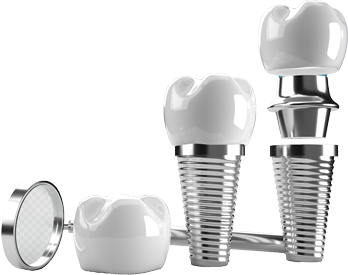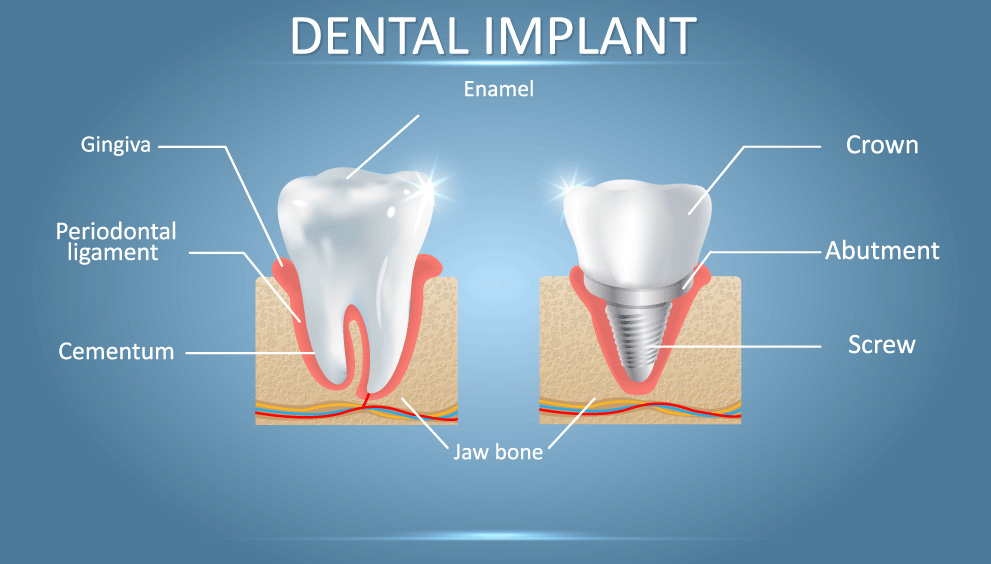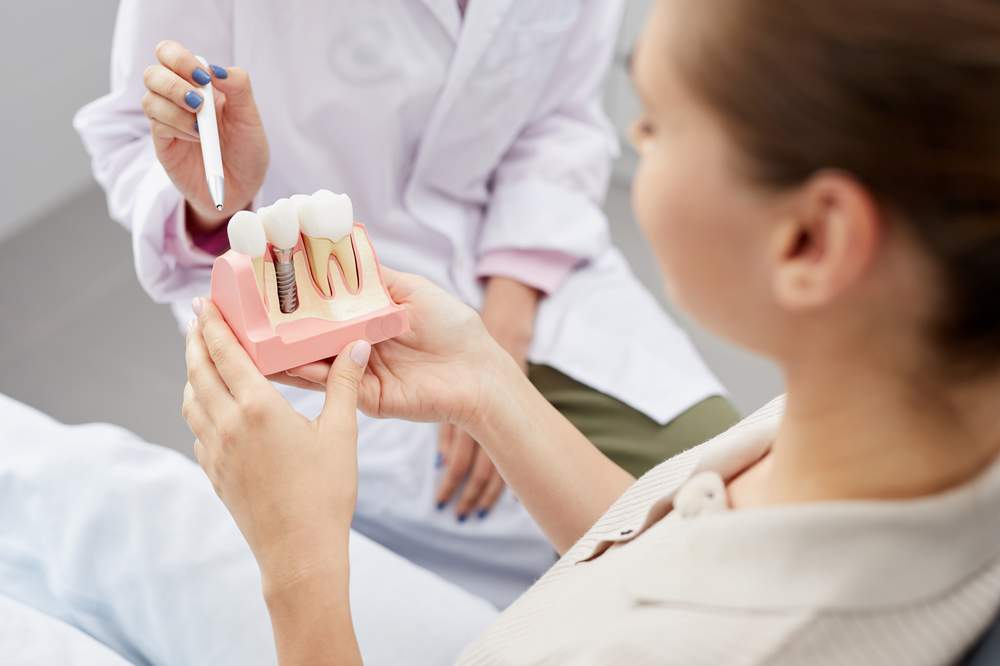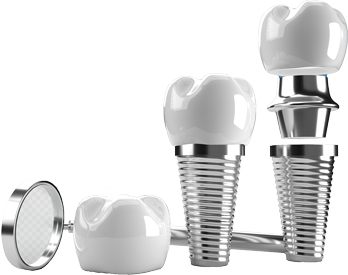Dental Implants : A Comprehensive Guide

What is an implant
A dental implant is a metal post that replaces one or more teeth, roots and jawbone. It acts much like the root of natural tooth with an attached anchor in your jaw so it doesn’t move around while you chew. They are made from titanium or ceramic materials which can be coated with porcelain to make them look beautiful and blend into your mouth perfectly.
Dental implants act as a scaffold for replacement tissue such as gums to attach itself but they must first undergo surgical placement before any work can be done on the surrounding area.
Dental implant therapy has evolved over time as new methods for implanting them have been implemented in recent years. These days, dentures can be supported by implants without any issues because new bone forms around the implant to firmly hold it in place and stabilize a single crown or even an entire denture.
There is less risk of infection with this procedure, making it more appealing to many people who are scared of undergoing dental surgery due to its potential complications.
There are three types of dental implants: direct, indirect, and hybrid.
Direct dental implants create a secure foundation while indirect implant creates an attachment between two adjacent teeth in order to secure the tooth restoration with its surrounding bone.
A hybrid implant is a combination of both the direct and indirect types. It can be used for patients who have lost one or more teeth from either extraction or trauma that cannot support an immediate restoration via retention (direct) method due to factors such as long-term stability (indirect).
For those who don’t need immediate stabilization but still want increased comfort over time (hybrid), it’s usually recommended for situations where there would otherwise be on average greater than 1 mm distance between adjacent bony surfaces after placement which then allows space for the tooth tissue to continue in its natural position.

Types of Dental Implants
Patients and clinicians can select the configuration that is tailored for their situation based on their needs.
Though all dental implants replace missing teeth, they do so in a variety of ways. Each type of dental implant is distinguished by its positioning, materials, and brand. Most cases are unique and not just one type.
The site of a dental implant is dictated by the health of the patient’s jawbone. You may use one of the following implant types depending on these factors:
Endosteal implants
The most frequent form of dental implant is endosteal, which prevents a patient’s jawbone from eroding over time. Insertion of an endosteal implant necessitates a high level of bone density. Patients with poor bone density may need a bone transplant prior to the treatment to strengthen the jaw.
They are made up of three parts:
- The implant, which is inserted into the jawbone for strength
- An abutment, which connects the implant to the new tooth or teeth
- And the new tooth, also called a dental prosthetic This is a relatively new alternative to traditional dental implants and bridgework, which can be both expensive and time-consuming. These strong three-piece implants are made of titanium, which means they’re stronger than other implants. And since the implant is inserted into the jawbone for strength, it can
The jaw implant, abutment and the connection part of the prosthetic are made of surgical-grade titanium. These surgical implants give dentists and oral surgeons the ability to fix problematic teeth and mouth structures with a long-term solution and deliver pain-free smiles in the process. They are an alternative to removable dentures and bridgework.
Subperiosteal implants: These implants are put behind the gums. The primary distinction between subperiosteal and endosteal implants is that subperiosteal devices are placed on or above the jawbone rather than incorporated in it. Patients who do not have enough healthy jawbone to sustain an endosteal implant and do not want to have a bone transplant to repair the jawbone often utilise these implants.
The key difference between subperiosteal and endosteal implants is that subperiosteal devices are not embedded in the jawbone but placed on or above it.
A doctor will evaluate a patient’s jawbone density to decide which implant location would best preserve the patient’s mouth while also taking the patient’s desires into account.
Alternative Techniques for Dental Implants
In addition to the typical multi-step dental implant surgery, your dental implant dentist may recommend various alternative treatment choices based on the condition of your jawbone and your unique requirements. Among the possibilities are:
Patients with low bone density may require a bone graft before getting dental implants. If your jawbone is not strong enough to support dental implants, there are numerous methods that may be utilised to repair bone, restore your natural jawline, and offer a solid foundation for implant-supported teeth. These are some examples:
Bone augmentation
This entails rebuilding or growing bone in your jaw when it is otherwise incapable of supporting implants. According to research, employing bone supplements and growth elements to reinforce the bone yields the greatest outcomes.
Sinus lift
This procedure, also known as sinus augmentation or sinus elevation, involves the addition of bone below the sinus in situations where native bone has deteriorated owing to missing upper back teeth.
Ridge expansion
If your jaw is too narrow to accommodate dental implants, bone graft material may be added to a little ridge or gap produced at the top of your jaw.

In most cases, when individuals discuss dental implants, they are referring to a particular kind of implant – those composed of a titanium-alloy alloy.
Some dentists and oral surgeons, on the other hand, provide implants made of stainless steel and non-metal materials (such as zirconia) in addition to traditional titanium implants.
In spite of the fact that each kind of implant has its own benefits, titanium implants are commonly considered to be the best choice for the majority of patients. Some of the advantages of titanium dental implants that make them such a superb tooth replacement option are as follows:
Titanium Implant Advantages
Titanium is biocompatible and has many advantages over other materials such as stainless steel, gold and titanium dioxide. It provides a stable base for teeth to rest on which will allow them to grow properly without causing any damage.
- Titanium should be considered by those who have multiple failed implants or extensive healing problems because they offer several advantages over other types of implant material, such as resorption rates (how much bone grows back around the implant) and healing times.
- Titanium is a hypoallergenic metal that is resistant to fracture, withstands bending forces well, and is completely non-toxic.
- They provide a long-lasting solution and can last a lifetime. In fact, over 95% of the people who have undergone this procedure have reported success rates with titanium implants.
- A titanium dental implant is a durable and long-lasting option. It’s resistant to acids, works well with the jawbone, and can help preserve it. Furthermore, after its insertion into the bone or gum tissue, it prevents and reverses bone loss that may have been occurring as a result of tooth loss.
- The titanium implants are not recommended for people who have metal allergies or sensitivities because of their three-piece construction and concentration of metals, which can cause allergic reactions in some cases.
Zirconium Implant Pros and Cons
Zirconia dental implants have been used in Europe for over a decade, and they have experienced widespread acceptance. They are not suitable for everyone, but sometimes is the only viable option. They can be aesthetically pleasing to those who are looking for an alternative to natural teeth. The Zirconia implant allows for customization of abutment results because it can be shaped into various types of designs with a variety of different shapes and sizes.
One of the most significant benefits of this material is its low modulus of elasticity and white colour, which make it very aesthetically pleasing. Furthermore, ceramics have excellent flexural strength and are known to be superior than other materials in terms of fracture toughness.
Zircons can also handle thermal shocks well because they’re resistant to high temperatures compared to other materials. To sum it up, zirconia is an ideal material for dental implants because of its low modulus of elasticity and white colour which makes them very aesthetically pleasing; flexural strength; thermal shock resistance; and good fracture toughness.
In osseointegration, zirconia is as good or even better than titanium. The contact between implant and jaw bone allows for stronger osseointegration because it’s less likely to break in an end-of-life scenario.
Additionally, the process of inserting a dental implant with zirconia can be done faster and more safely without any complications when compared to other materials like metal alloys that requires extra steps such as polishing and heating up the surface area.
However, there are some drawbacks to this type of material that you should be aware of before choosing it as your treatment choice: low-temperature degradation is one such drawback which can lead to failed treatments in cases where the temperature dips below freezing; ASEPTIC LOOSENING is another issue with the material that can lead to failed treatments in cases where the implant is placed too close to a blood vessel; 2-piece zirconia dental implants have limitations when it comes to abutment angulation.
There are a few reasons why people choose to use zirconia dental implants, but there is no consensus yet on the best reason. Some say that biocompatibility with humans makes it the perfect material for all types of patients, while others believe that this lack of research into possible peri-implantitis and metal allergies make it an ideal choice for them.
Therefore, if you’re considering this type of treatment as your future choice for replacing missing teeth, be sure to consult with an experienced dentist who will give you all necessary information about what’s best for achieving the desired result and how long it’ll take before you get there.
Zirconia dental implants are an effective choice that provides the best of both worlds, making them a viable option for patients.

Dental Implants Procedures
Dental implant surgery requires a high degree of coordination between patients and their clinicians in order to be successful.
Patients and physicians may select which techniques are appropriate at each stage and how to continue in the appropriate manner.
Before, during, and after a dental implant process, you should be aware of the following things:
Prior to the procedure
Before beginning the procedure, it is important to understand:
As soon as a doctor determines that a patient requires dental implants, he or she will consult with the patient to establish the specifics of the operation.
This may include making judgments on things such as:
- Implants placed endosteally vs subperiosteally
- Implants made of titanium against zirconia
- Which brand of implants should be used?
- Comparing the use of a conventional method against an alternative method
Preparation for dental implant placement is important, and a surgeon may explain how he or she will place the implants and ensure that the patient is appropriately prepared for the specific dental implant type and method that will be employed.
During the Procedure
The following are some of the things you might anticipate to happen on the day of the operation for dental implant surgery:
If there is still a tooth that has to be extracted, the oral surgeon may do it just before the implant is put in place.
Local anaesthetic will be administered by the surgeon to numb the patient’s mouth.
The surgeon will make an incision into the patient’s gums in order to reveal the bone under the surface of the gums.
A special drill will be used to make a gap in the jawbone for the implant if the surgeon is placing an endosteal implant into the patient’s mouth.
The implant will be placed into the hole by the surgeon and secured with sutures.
Surgeons may need to repeat this step numerous times in various areas, depending on the kind of surgery and method employed.
One to two stitches will be used by the surgeon to close all of the holes.
If the surgeon chooses to use the instant load or All-on-4 approach, he or she will subsequently attach a temporary crown to the implant.
The implant will need to be allowed to cure for many weeks before the permanent crown can be placed on it.
After the Procedure
Patients will have varied degrees of awareness after the surgery, depending on the kind of anaesthetic utilised during the treatment.
Patients who have had a dental implant operation may encounter common symptoms such as the following while recuperating:
- Gums or skin that has been bruised
- Face or gums that are swollen
- Minor bruising and bleeding
- Pain at the location of the procedure
If you are experiencing discomfort, your dentist may recommend pain medicines or antibiotics to help relieve it.
Patients will need to consume soft meals for seven to ten days after the operation to allow their mouths to recover properly after the procedure.
Patient’s general health, as well as the quantity of teeth implanted, will determine how long it will take for them to recuperate after the procedure.
While the implant is healing, a dentist may create a lifelike crown that will be placed on top of the implant after it has healed.
Once the implant has healed, a surgeon may connect it to the abutment using a screwdriver or other instrument.
Potential Procedural Risks and Side Effects
The process of replacing a tooth with an implant is not for everyone. To ensure that patients have healthy enough bone structure and can heal properly after treatment, careful planning is important before undergoing the procedure. A patient’s medical history, allergies, and other existing conditions must be carefully reviewed before they undergo any type of dental surgery or dental work in general.
Dental implants, though relatively safe, have a small risk for injury to the nerves that supply the face and gums. The most important thing is not to rush into dental implant surgery without doing your research first.
The risks of dental implants are quite low and they have a high success rate. Success rates can be as high as 95%. In the unlikely event of infection, fracture, or overloading, another attempt to replace the failed implant might be made after requisite time for healing has taken place.
Careful planning with a qualified surgeon can help avoid these problems.
The Cost of Dental Implants
The cost of an implant in Sydney ranges from $3,000 to $7,000 per implant. Multiple variables have an impact on these values.
- The cost of a dental implant treatment is between $5,000 and $5,500.
- $5,500 to $6,500 for a more complicated single dental implant.
- ‘Full arch’ dental implant treatment:
$20,000-$30,000
The overall cost of your dental implant treatment will be determined by a range of variables, including where your missing teeth are situated in the mouth, the kind of dental implant utilized, and whether or not you need a surgery to increase bone volume before your implants are put.
If you have health or dental insurance, you may be able to have a portion of the cost of your dental implants covered.
The reason dental implants are more expensive than alternative solutions is straightforward.
For the most effective installation and restoration, the surgery requires exceptional accuracy and sophisticated treatment planning, therefore you should consult with a highly qualified professional.
Many general dentists can fit you for a denture or instal a standard crown and bridge, but only a handful are trained to provide full implant care.
Of course, the procedure of implantation isn’t inexpensive either for your implant dentist.
Treatment planning necessitates the use of a Cone Beam CT scanner to capture three-dimensional pictures of your oral anatomy.
Each dental implant is constructed of biocompatible titanium, a unique material that can merge with your jawbone for unrivalled stability.
In addition to local anaesthetic, most patients like to be helped relax throughout their operations.
Although oral conscious or intravenous sedation during dental implant operations may substantially enhance the overall experience, it does increase to the expense of your dental implant treatment.
Furthermore, persons who have had missing teeth for a long period (months or years) have most certainly already experienced the bone loss and degeneration that impedes appropriate healing after a dental implant treatment.
Before your dental implants may be put, your implant dentist may propose bone grafting and sinus lift operations.
Most dental insurance policies require patients to choose the least costly restorative dentistry option, which includes tooth replacement. Rather than dental implants, many dental insurance companies will cover classic crown and bridge treatment or non-implant retained dentures.

Dental Implants FAQs
What kind of care do implants require?
Dental implants require a lot of care and maintenance because they may become damaged over time or worn out through regular use. The implant will be covered by your natural teeth, but proper oral hygiene should still be followed.
Implants may also need to be replaced with crowns if they have been worn down due to normal wear-and-tear from brushing and eating foods such as crunchy things like corn chips that can damage the implant. Implants require care similar to that given for natural teeth. The piece that connects the crown to the implant can also become worn and break, requiring replacement.
How Do I Care for Dental Implants?
By following these simple steps you can ensure the integrity of your dental.
1) Tooth brushing in general is important because it helps keep your gums healthy and your mouth clean.
2) Flossing daily helps remove plaque build-up on between your teeth.
3) Regular dental checkups are important because they help monitor the health of your teeth, gums and jawbone.
!
Does insurance cover the cost of dental implants?
As it becomes obvious that dental implants provide the utmost in long-term tooth replacement while also benefiting oral and general health, several dental insurance policies are starting to broaden coverage to include implant dentistry.
Dental insurance often covers the difference between what your policy covers and what you must pay for dental implants. For instance, if the cost of a dental implant is $2,500 and your plan pays for 80% of dental care expenses, then you will only have to cover 20% of the cost.
As a result, most insurance plans cover the cost of dental implants. In addition, these accounts offer flexibility and convenience for consumers. Dental insurance is paying for a small percentage of dental implants. Coverage may vary by procedure and cap amount, but the average reimbursement is $1,500 per implant.
If you want to get dental implants, it’s recommended that you check with your insurance provider before making a final decision. If the cost of getting dental implants is not covered by your plan, then make sure to find out what other costs will be associated with the procedure and how much they will be if they are not included in your policy.
Furthermore, even if your dental insurance does not cover implants, your health insurance may.
How are implants better than bridges?
It is critical to spend time learning about the distinctions between these solutions.
Dental implants permanently replace the natural root of the tooth (through a titanium post that links to your bone) to provide a firm foundation for the new crown.
A new crown is created based on a mould of your bite, and it is permanently affixed to the post.
Dental bridges are made up of crowns on both sides of the gap (which may be natural teeth or dental implants) and a prosthetic tooth or teeth that “bridges” the space.
The crowns are affixed to this filler tooth.
Simple enough, however there are a few differences to consider while deciding between a dental implant and a dental bridge:
Protection of neighbouring teeth — Because the surrounding teeth serve as the basis for a dental bridge, they might deteriorate with time, particularly when the bridge is changed.
Dental implants keep neighbouring teeth from loosening and your jaw bone from resorbing as a result of lost teeth.
Maintenance – Without a doubt, implants are much simpler to maintain than natural teeth since they can be cleaned in the same way.
Bridges, on the other hand, are more difficult to maintain clean.
You’ll need to clean under the bridge and between the teeth that support it, as well as maintain the gum tissue clean.
Price — While dental implants are initially more costly than bridges, they are a considerably better long-term investment.
Bridges should be replaced every 5-10 years, however dental implants should last a lifetime if properly cared for.
Bone volume – If your jaw has been severely injured or you’ve seen major bone loss, your dentist may believe that a dental bridge is your only alternative.
While this was historically true, the All-on-4 dental implant technique makes practically anybody a candidate—even those with bone loss.
Durability – Bridges need maintenance and must be replaced on a regular basis.
Implants are surgically implanted, resulting in a long-term, sustainable solution that will not need replacement as long as you maintain appropriate dental hygiene.
Dental implants are often thought to provide several benefits over dental bridges.
